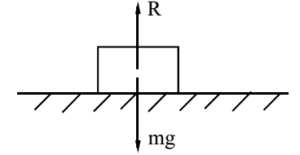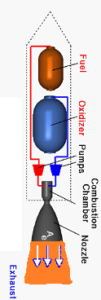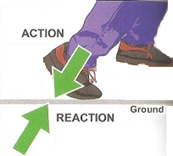Science > Physics > Force > Newton’s Third Law of Motion
In this article, we shall study Newton’s third law of motion and the concept of action-reaction pair of forces.
Statement:
To every action, there is always equal, opposite and simultaneous reaction.
Explanation:

Let us consider a block of metal kept on the table. The weight of the block acts vertically downward. Thus the block tries to push the surface of the table downward by a force which is equal to its weight. This is the action. Now the surface of the table pushes the block vertically upward which is the reaction.
Here it should be noted that action and reaction act simultaneously. The action is on the table while the reaction is on the block. Thus action and reaction act on two different bodies. Hence though action and reaction are equal they can not cancel each other’s effect.
Examples to Illustrate Action Reaction Pair:
Example 1: To explain the third law of motion we can take an example of the working of a rocket. When the fuel of the rocket is ignited the combustion of fuels takes place. The hot gases produced in the chemical reaction are pushed out through the small hole at the bottom (tail) of the rocket with very high velocity. Thus the action is downward. Now, these outgoing gases produce an equal and opposite force on the rocket, which constitutes the reaction. Under the effect of upward reaction, the rocket is propelled upward. The jet engine also works on the same principle, the difference is that the rocket has to carry oxygen or an oxidizing agent with it to propel because it has to go out of the atmosphere of the Earth where oxygen is not available. While planes with jet engines fly in Earth,s atmosphere, hence they need not carry oxygen with them.

Example 2: Let us sit on a chair in front of a wall and push the wall with our legs. We will find that the chair is pushed backward. When we are pushing the wall we are applying action force, now the wall will put equal and opposite reaction on us and the chair is pushed backward.
Example 3: When we walk on the ground, as our foot pushes down (action) the ground, the ground pushes up (reaction) which is equal and opposite. This reaction is responsible for our forward movement. If the ground is not able to give a required reaction, then our foot sinks in it as in the case of sand, mud, water etc. If we push the ground harder we can jump into the air.

Example 4: Two-wheeled blocks of the same kind are at rest on the top of a smooth surface of a table. They are tied with a thread with each other. A compressed spring is placed between the two blocks. When the thread is cut the blocks move in the opposite direction.

Example 5: If we attach a spring balance to the hook on the wall and its hook is engaged with a hook of another spring balance and apply a pull on the second spring balance that both of the spring balance show the same reading but in opposite direction.
Example 6: The ball bounces back on hitting the ground. A ball strikes the ground with certain force (Action) and the ground pushes back the ball with equal force(Reaction)

Example 7: A gun recoils when a shot is fired from it. Initially both the bullet and gun are at rest, thus the total momentum of the system is constant. When a shot is fired, the bullet moves forward pushing the gun backward. This phenomenon is called the recoil of the gun. Due to recoiling of the gun, a backward jerk is experienced on the shoulders by the shooter. Hence to avoid injury he has to hold the rifle holding tight on shoulders.

Example 8: When a boy jumps from the boat to the bank. The boat moves in the direction opposite to jump. In order to jump out of the boat, he has to push the ground (surface of the boat) with greater force (action). Now the boat is in water, thus it is representing the non-rigid surface. Thus the boat moves backward under the action of pushing force.

Example 9: While swimming, the swimmer pushes the water backward with his hands. The action of pushing water backward gives rise to a reaction in the opposite direction which results in the swimmer moving forward.
Example 10: While hammering a nail. a force is experienced on the hand holding the hammer. When a nail is hammered a force is applied to it (action) due to which the nail applies equal and opposite reaction on the hammer.
Example 11: When moving train collides with a stationary one, the former experiences a reverse motion. The moving train applies a force on the stationary train and in return, the stationary train puts a reaction which is equal and opposite to the former train.
Example 12: A person falling from a certain height on a hard surface gets hurt more seriously than when he falls on a soft surface. By Newton’s third law of motion “to every action, there is always equal, opposite and simultaneous reaction. Thus when the person falls on the surface its weight (action) acts on the surface in turn the surface puts equal and opposite reaction on the person. Now the hard surface is rigid it transfers complete reaction without absorbing any impact (energy). Thus hard surface puts more reaction on the person. While the soft surface is elastic it transfers part of reaction absorbing some impact (energy). Thus soft surface put less reaction on the person. Thus hard surface is providing greater reaction than the soft surface. Hence, the person falling from a certain height on a hard surface gets hurt more seriously than when he falls on a soft surface.
Previous Topic: Newton’s Second Law of Motion (Concept of Momentum)
Next Topic: Applications of Newton’s laws
